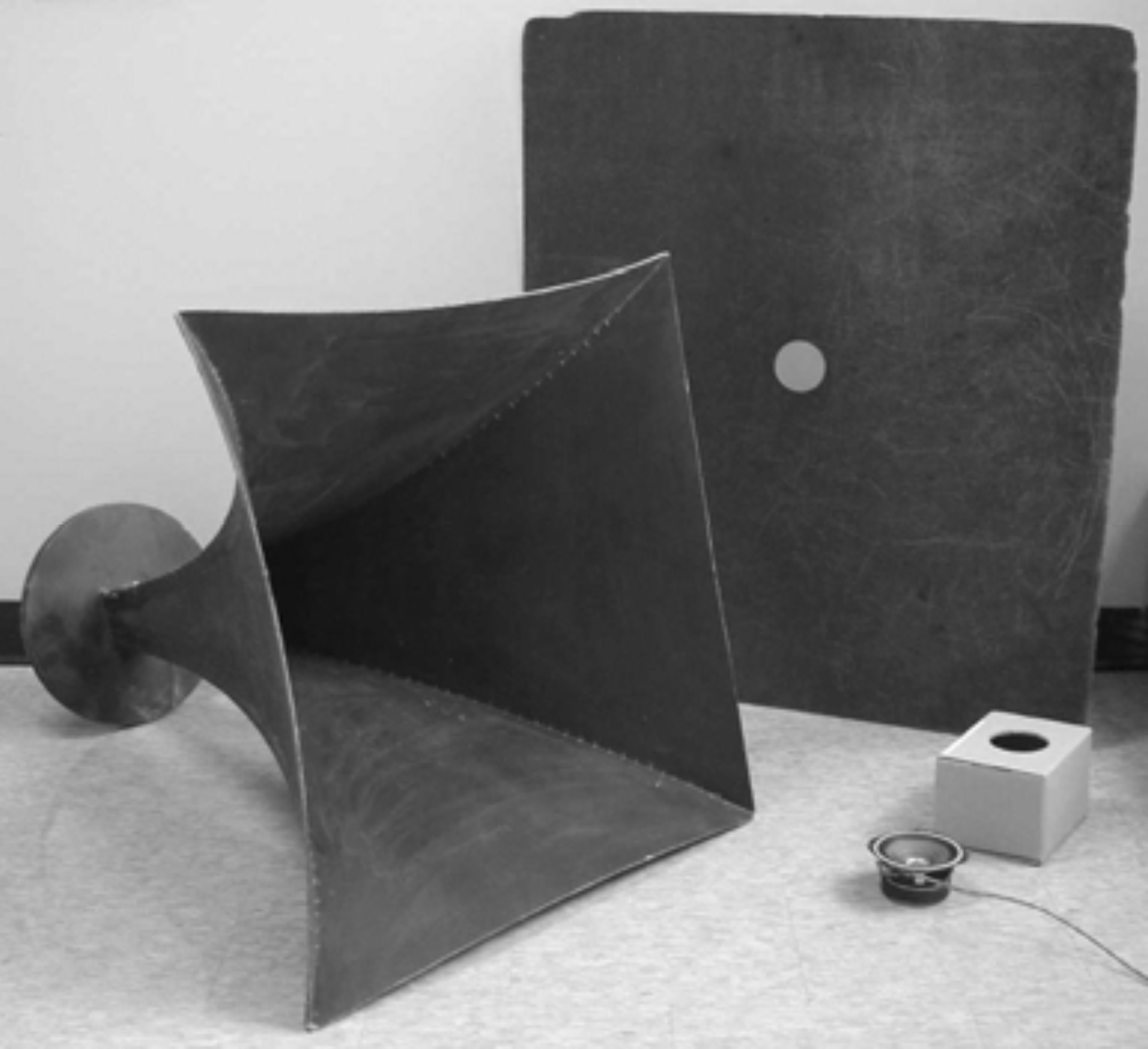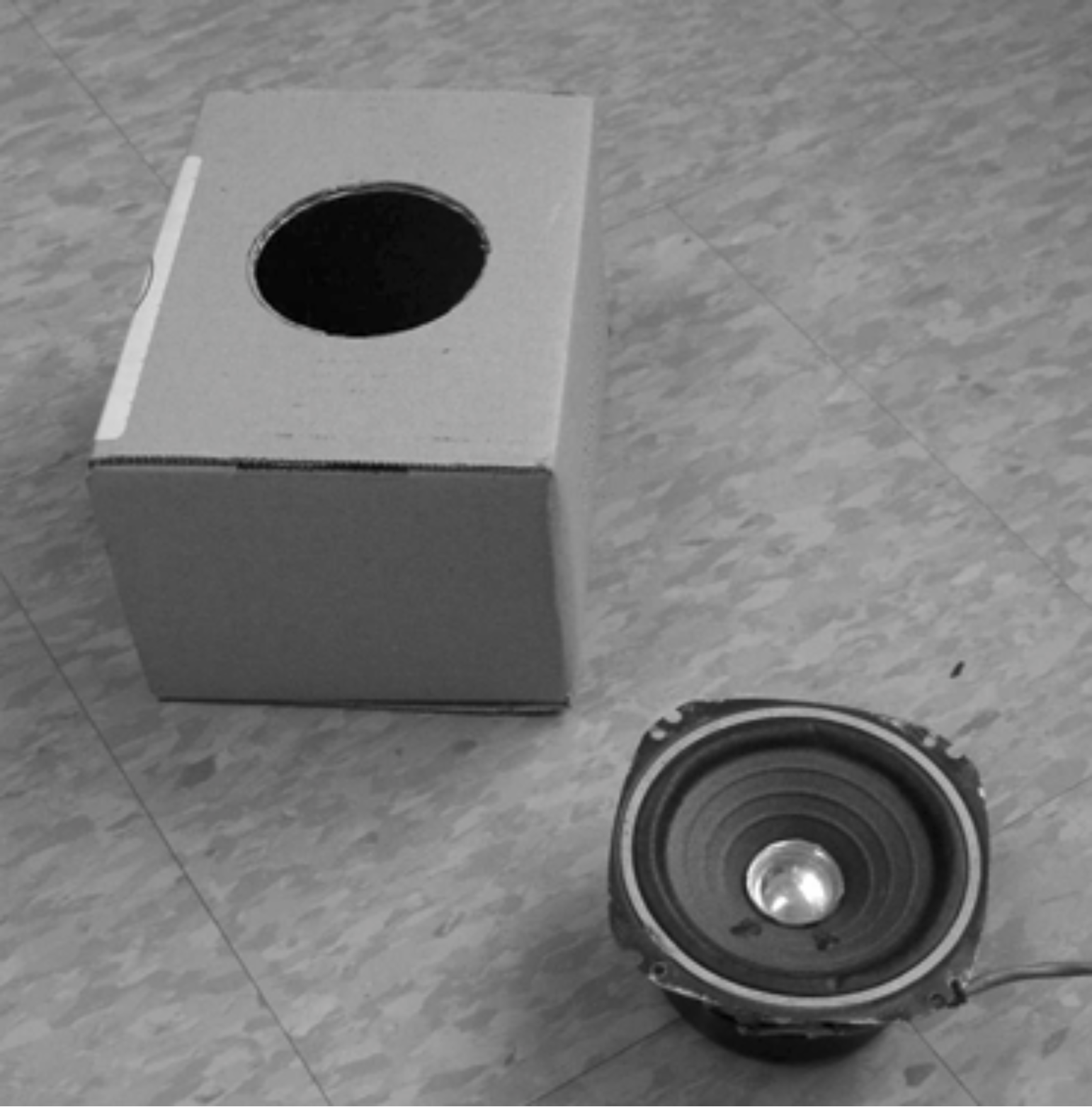John Vanderkooy, Distinguished Professor Emeritus Department of Physics and Astronomy, University of Waterloo
For this demonstration, a small open loudspeaker driver is necessary, driven from a sound source with output power sufficient for a loudspeaker. A ghetto-blaster is convenient if it has an output jack or can be modified to direct the loudspeaker output to an external device. For best results the small driver should be of moderate or better quality. It helps if its compliance is high so that bass notes cause substantial cone motion.
When listened to by itself, the sound is thin and wispy, with largely treble output and no bass. If several square sheets of cardboard are provided with dimensions of, say, 40×40 cm, and 1×1 m, these can have holes cut into their middle so that the small driver will seal relatively well to these baffles. The smaller baffle causes the sound to improve dramatically, with much more midrange balancing the sound. The larger baffle will restore even more of the bass. With rock music the effect is very dramatic! You can listen to either side of the baffle.
 Figure 1: Equipment: speaker, baffle, cardboard box, and exponential horn.
Figure 1: Equipment: speaker, baffle, cardboard box, and exponential horn.
If you have the resources, try to build an exponential horn such as shown in Fig. 1. It not only gives a balanced full- range sound, but the loudness is much higher.
 Figure 2: Cardboard box and speaker.
Figure 2: Cardboard box and speaker.
As a final demo, place the driver over a sealed container, say a small dewar, or a closed cardboard box with a hole cut into one face (Fig. 2). The sound will be rich and full again.
With the baffles, horn or box, the sound will revert to its poor condition very quickly if the driver is moved even a centimetre or two from a good seal with the baffle.
Understanding it all
Sound is a longitudinal pressure wave in air, and it is produced by sources that provide appropriate air motion. A radially oscillating small balloon would produce sound pressure that radiates spherically outwards, proportional to the radial surface acceleration of the balloon. If the balloon produces say a volume acceleration (surface area of balloon
S multiplied by its surface acceleration
a, units m
3/s
2) of
A =
S a, we can show from Newton’s second law of motion and the ideal gas law that the sound pressure
p at distance
r from the balloon’s centre will be

where
ρ is the density of air, and the factor 4π comes from the fact the sound is spreading out over a solid angle of 4π steradians.
The problem with our open driver is that it produces two sound sources, one on each side of the cone, that are exactly 180° out of phase. This causes cancellation at those frequencies where the path difference between front and back sources is less than half a wavelength, and thus the lower frequencies, having longer wavelengths, are progressively more cancelled, leaving only the treble. A baffle increases the path difference, reduces the cancellation of the lower frequencies and improves the midrange and bass response. For a 1 m square or round baffle, the path difference of 1 m progressively causes only those sounds below about 150 Hz (corresponding to 1/2 wavelength) to be cancelled, and that makes it sound good in a demonstration.
The horn causes the efficiency of the sound source to rise remarkably, since the confinement of the air in the throat increases the pressure there. Thus the moving cone does more thermodynamic work on the air, producing more acoustic energy. The horn eventually spreads out and allows this energy to move into free air. Although we have stated that for a free source spreading sound into 3 dimensions, the pressure amplitude is given by the volume acceleration, in a horn the sound is more 1-dimensional, and then the pressure amplitude is proportional to the volume velocity of the source (units m3/s), with much higher efficiency.
The small box prevents the sound inside the box from cancelling that which comes from the front, so the sound has a full-range character. Naturally we would mount the driver with its cone facing outwards, but all students will see that this is the origin of the box loudspeaker. Of course there are refinements; the box may be filled with sound absorbing material, or it may have a port to give resonant enhancement of the bass. Only the bass creates the need for a box of substantial size; in fact for normal loudspeakers the size of the box is inversely proportional to the cube of the lowest frequency it will reproduce. Halving the lower cutoff frequency requires eight times as large a box! That is why satellite speakers, which respond only down to say 80 Hz, can be quite small. The single subwoofer accompanying the satellite speakers often has a reduced-size box as well, but then it must have a powerful amplifier that just pushes and pulls harder on the air in the box, giving good bass.
Column Editor: Ernie McFarland, Physics Department, University of Guelph, Guelph, Ontario, N1G 2W1 Tags: Waves and Sound



